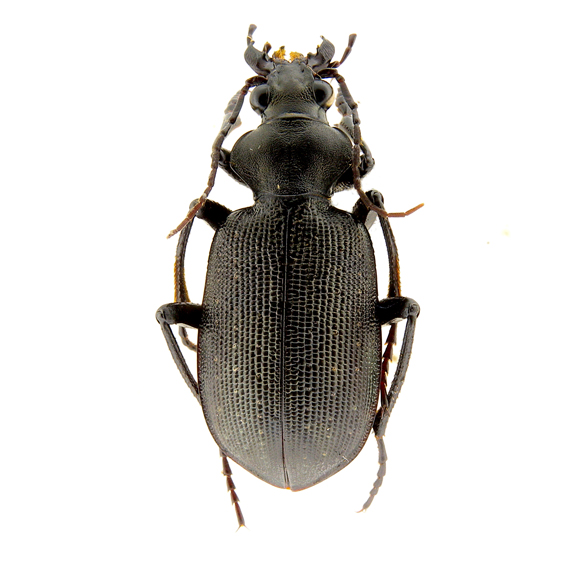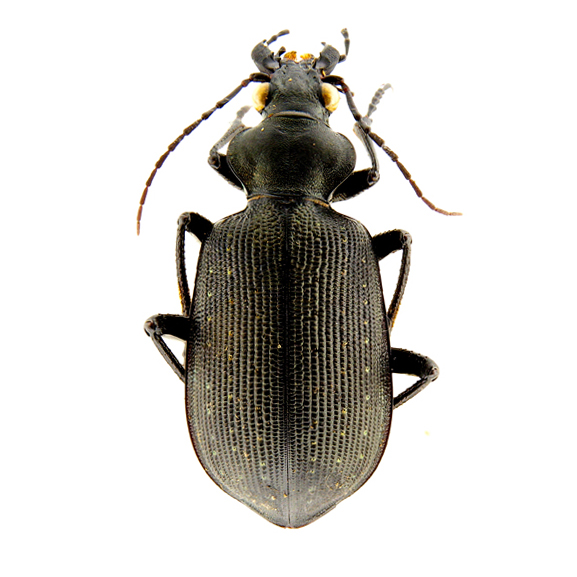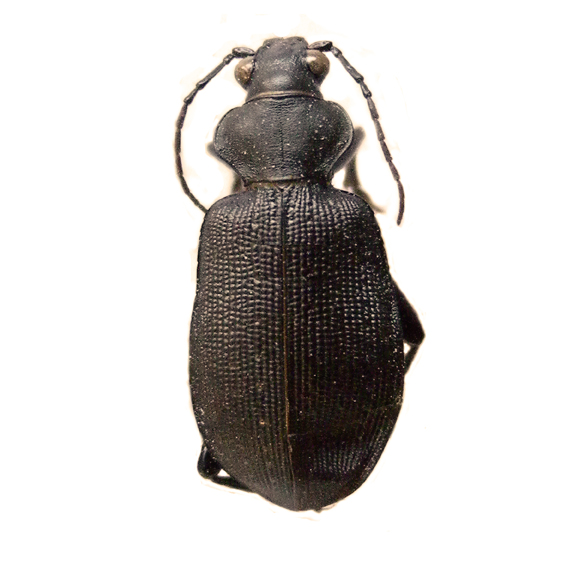Calosoma (Ctenosta) orientale Hope, 1833
Calosoma orientale Hope, 1833: 61 (described from: Poona) type possibly lost (Roeschke, 1900: 61; Andrewes, 1919: 202)
Calosoma squamigerum Chaudoir, 1869: 368 (type material: 2♂♂ from: Bengala and Madras), lectotype ♂ (from Bengala) designated by Deuve (1978: 250) in Muséum National d'Histoire Naturelle, Paris [examined]
Calosoma (Ctenosta) squamigerum Breuning, 1927: 184
Calosoma (Ctenosta) orientale Lapouge, 1932: 414
Ctenosta orientale Jeannel, 1940: 128
Length 25-26 mm. C. orientale has the same model of elytral sculpture than C. roeschkei and C. scabrosum. As C. scabrosum, C. orientale has the pronotum narrowed behind but its widest part is a little after the middle and the basal dimples are rather shallow. Moreover, in the elytra, the intervals are less raised and less incised and the color of upper side of the body is dull black, sometime with feeble metallic luster limited to the borders.
Jeannel (1940: 128) cites it as present in the East Africa: Tanzania, Kenya, Eritrea, but all quotations of Jeannel for Africa should be related to C. roeschkei (= aethiops), as already noted by Rougemont (1976: 247).
Actually, C. orientale lives on both sides of the Himalayan range. It is widespread in the Indian peninsula, including the island of Ceylon (coll. Migliaccio), and has recently been found in China, from Tibet and Yunnan, to the island of Hainan (Deuve, 2013: 73)
Examined specimens and literature’s data:
China. Hainan: Wuzhi Shan (Deuve, 2013: 73); Xizang (Tibet): Linzhi City (SB); Yunnan: Shuangbai (SB), Yuxi (www.inaturalist.org)
India. Bihar: Chapra (Andrewes, 1929: 69); Chhattisgarh: Sagona (www.inaturalist.org); Gujerat: Vadodara, Bhavnagar, Godhra, Janmagar, Surat (www.inaturalist.org/); Jammu and Kashmir: Leh (Ladakh) (www.inaturalist.org); Karnataka: Bangalore, Chikmagalur (RMCA); Madhya Pradesh: Panna Nat. Res. (EM, RS), Khandwa (Andrewes, 1929: 69); Maharashtra: Poona (=Pune) (type, Hope, 1833: 61), Melghat Tiger Reserve (Thakare & al., 2013: 175), Ahmadnagar (www.inaturalist.org/); New Dehli (GP, SB), Sanjay Van Park (www.inaturalist.org); Rajasthan: Jodhpur (Kumar S. et al.,2022: 22263); Tamil Nadu: Chennai (Madras) (AMNH), Coimbatore (Chaudoir, 1869: 36) (SB, EM, RS, TS), Masagoundanpudur (www.inaturalist.org/), Kodaikanal, Madura, Manaparai (Kumar S. et al., 2022: 22263); Telangana: Bhadrahalam (TL); Uttar Pradesh: Rae Bareli (www.inaturalist.org/); West Bengal: (Andrewes, 1929: 69), Bengala (holotype of of Calosoma squamigerum) (MNHN)
Pakistan. Punjab: Chakval (SB); Baluchistan: Khusdar (SB); Sindh: Tharparkar (SB); Islamabad (SB)
Sri Lanka. Anuradhapura (EM)
Notes: Diurnal and nocturnal, winged, attracted to light at night. The active individuals were mainly collected during the wettest periods, respectively from June to July at higher altitudes in the Himalayan foothills, and from August to November in the plateau or lower.
 Hope, 1833 India: Dehli,18.8.96, Pontuale lgt. |
 Hope, 1833 India: Dehli,18.8.96, Pontuale lgt. |
 Hope, 1833 Bengala (holotype of Calosoma squamigerum Chaudoir) (coll.Muséum National d'Histoire Naturelle, Paris) |